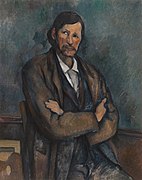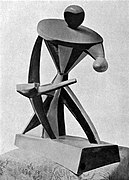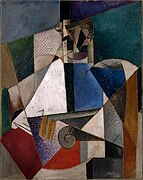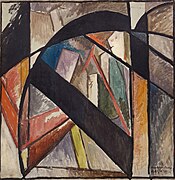Solomon R. Guggenheim Museum
The Solomon R. Guggenheim Museum, often referred to as The Guggenheim, is an art museum at 1071 Fifth Avenue between 88th and 89th Streets on the Upper East Side of Manhattan in New York City. It hosts a permanent collection of Impressionist, Post-Impressionist, early Modern, and contemporary art and also features special exhibitions throughout the year. It was established by the Solomon R. Guggenheim Foundation in 1939 as the Museum of Non-Objective Painting, under the guidance of its first director, Hilla von Rebay. The museum adopted its current name in 1952, three years after the death of its founder Solomon R. Guggenheim. It continues to be operated and owned by the Solomon R. Guggenheim Foundation.
"The Guggenheim" redirects here. For other Guggenheim Museums, see List of Guggenheim Museums.
The museum's building, a landmark work of 20th-century architecture designed by Frank Lloyd Wright, drew controversy for the unusual shape of its display spaces and took 15 years to design and build; it was completed in 1959. It consists of a six-story, bowl-shaped main gallery to the south, a four-story "monitor" to the north, and a ten-story annex to the northeast. A six-story helical ramp extends along the main gallery's perimeter, under a central ceiling skylight. The Thannhauser Collection is housed within the top three stories of the monitor, and there are additional galleries in the annex and a learning center in the basement. The museum building's design was controversial when it was completed but was widely praised afterward. The building underwent extensive renovations from 1990 to 1992, when the annex was built, and it was renovated again from 2005 to 2008.
The museum's collection has grown over the decades and is founded upon several important private collections, including those of Guggenheim, Karl Nierendorf, Katherine Sophie Dreier, Justin Thannhauser, Rebay, Giuseppe Panza, Robert Mapplethorpe, and the Bohen Foundation. The collection, which includes around 8,000 works as of 2022, is shared with sister museums in Bilbao, Spain, and Venice, Italy. In 2023, nearly 861,000 people visited the museum.[1]
History[edit]
Early years and Hilla Rebay[edit]
Solomon R. Guggenheim, a member of a wealthy mining family, began collecting works of the old masters in the 1890s.[7] In 1926, he met artist Hilla von Rebay,[7][8] who introduced him to European avant-garde art, in particular abstract art that she felt had a spiritual and utopian aspect (non-objective art).[7] Guggenheim completely changed his collecting strategy, turning to the work of Wassily Kandinsky, among others. He began to display his collection to the public at his apartment in the Plaza Hotel in New York City.[7][9][10] Guggenheim and Rebay initially considered building a museum at Rockefeller Center in Manhattan.[8] As the collection grew, Guggenheim established the Solomon R. Guggenheim Foundation, in 1937, to foster the appreciation of modern art.[8][9][11]
Restitution claims[edit]
In 2007, the heirs of Berlin banker Paul von Mendelssohn-Bartholdy requested the restitution of the Picasso painting "Le Moulin de la Galette" (1900), which they claimed he had sold under duress by the Nazis.[306][307] The museum and the heirs settled the lawsuit in 2009.[308] The presiding judge, Jed Rakoff, criticized the secrecy of the accord.[309][310] In 2018, the museum returned the Ernst Ludwig Kirchner painting Artillerymen (1915) to the heirs of Alfred Flechtheim, who had owned the painting before it fell into the hands of a Nazi collector in 1938.[311][312]
In 2023, the heirs of Karl and Rosie Adler sued the Guggenheim to claim the restitution of a Picasso painting, Woman Ironing (La repasseuse) (1904), which the Adlers sold to Justin Thannhauser in 1938, allegedly for a fraction of its value, to escape the Holocaust. They alleged that Thannhauser knowingly purchased the painting, and art from other Jews on the run, profiting unfairly from their distress.[313][314] The museum says they contacted the Adler family before acquiring the painting as a part of Thannhauser's bequest of his art collection in 1976, and at that time Karl Adler did not object.[315][316]
The Guggenheim lists 289 artworks on the Nazi Era Provenance Internet Portal (NEPIP) but does not publish provenance for its collection.[317][318]
Governance and staff[edit]
The Solomon R. Guggenheim Foundation operates and owns the Solomon R. Guggenheim Museum.[319] The foundation's art and museum committee is responsible for proposing acquisitions and deaccessions from the foundation's collection, while the foundation's board of trustees determines whether to enact the art and museum committee's proposals.[320] J. Tomilson Hill has served as the board's chair since 2021,[321] while Marcy Withington has been the foundation's chief financial officer since 2018.[322] As of 2022, Richard Armstrong is the director of both the Guggenheim Foundation and the museum.[319] The museum employed 315 full-time and part-time staff members in 2020.[323][324]
Reception and commentary[edit]
Contemporary views[edit]
Even before the building opened, the design polarized architecture critics[89][325] and was controversial among the public.[326][327] Some critics believed the building would overshadow the museum's artworks.[328] Emily Genauer of the New York Herald Tribune said the building had been likened to "a giant corkscrew, a washing machine and a marshmallow",[329] while Solomon's niece Peggy Guggenheim believed it resembled "a huge garage".[330] Members of the public felt that the building contrasted with the character of Fifth Avenue.[327] Other critics, and many artists, worried that it would be difficult to properly hang paintings in the shallow, windowless, concave exhibition niches around the main gallery.[331][77][89] Prior to the opening of the museum, 21 artists signed a letter protesting the display of their work in such a space.[87][332] Phyllis Mark of the New Leader commented that the walls and ceilings would "disorient the viewer" and noted that the museum could only display five percent of its collection in the new building.[268]
Art critics reviewed the structure especially harshly.[333] John Canaday of The New York Times wrote that the design would be worthy of merit if it were "stripped of its pictures",[334][335] while Hilton Kramer of Arts Magazine opined that the structure was "what is probably [Wright's] most useless edifice".[336] Architectural critic Lewis Mumford summed up the opprobrium:
Attendance[edit]
When the building opened, it was popular with the general public.[366] A 1960 Gallup poll found that 38 percent of visitors came for the building itself, while an additional 43 percent wanted to see both the building and the art.[366][367] The Guggenheim did not keep precise attendance records until 1992.[368] Before its 1990s renovation, it had an estimated 600,000 annual visitors.[369] This increased to between 900,000 and 1 million by the early 2000s.[183] It had 960,000 annual visitors before the September 11 attacks, but attendance decreased below that level for several years after the attacks.[199] In 2013, nearly 1.2 million people visited the museum, and its James Turrell exhibition was the most popular in New York City in daily attendance.[370] Due to the COVID-19 pandemic, the Guggenheim had only 154,000 visitors in 2020, an 88 percent decrease from the preceding year.[371] In 2023, the museum had 861,000 visitors, compared with 1.2 million in 2019 (before the COVID-19 pandemic).[1][372]
According to museum officials, surveys over the years have indicated that most visitors came because of the building's architecture rather than its artwork.[183] In 2001, The New York Times reported that nearly 70 percent were tourists, and that half were foreigners.[192] In 2010, the Times reported that 55–65 percent of visitors were from the New York metropolitan area.[373] According to a 2018 study, 73 percent of the museum's visitors were white and 8 percent were black.[213]
In 2009, a Frank Lloyd Wright retrospective attracted 372,000 visitors in three months, becoming the museum's single most popular exhibit.[374] This record was broken the next year by a Kandinsky exhibit.[368][373] As of 2022, the most popular exhibition in the museum's history was a 2019 exhibition of Hilma af Klint paintings,[375] which attracted over 600,000 visitors in six months.[376]

















